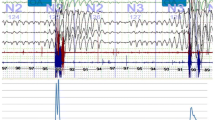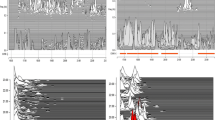Abstract
Background
The high prevalence of sleep disordered breathing (SDB) among heart diseases patients becomes increasingly recognized. A reliable exploring tool of SDB well adapted to cardiologists practice would be very useful for the management of these patients.
Methods
We assessed a novel multi-modal electrocardiogram (ECG) Holter which incorporated both thoracic impedance and pulse oximetry signals. We compared in a home setting, a standard condition for Holter recordings, results from the novel device to a classical ambulatory polygraph in subjects with suspected SDB. The analysis of cardiac arrhythmias in relationship with SDB is also presented. A total of 118 patients clinically suspected of having SDB were evaluated (mean age 57 ± 14 years, mean body mass index [BMI] 32 ± 6 kg/m2). The new device allows calculating a new index called thoracic impedance (TI) disturbance index (TIDI+) evaluated from TI and SpO2 signals recorded from a Holter monitor.
Results
In the population under study, 93% had more than 70% of usable TI signal and 95% had more than 90% for SpO2 during sleep time recording. Screening performance results based on automatic analysis is accurate: TIDI + demonstrates a high level of sensitivity (96.8%), specificity (72.3%) as well as positive (82.4%) and negative (94.4%) predictive value for the detection of SDB. Moreover, detection of SDB periods permits us to observe a possible respiratory association of several nocturnal arrhythmias.
Conclusions
The multi-modal Holter should be considered as a valuable evaluating tool for SDB screening and as a case selection technique for facilitating access to a full polysomnography for severe cases. Moreover, it offers a unique opportunity to study arrhythmia consequences with both respiratory and hypoxia disturbances.



Similar content being viewed by others
References
Young T, Palta M, Dempsey J, Skatrud J, Weber S, Badr S (1993) The occurrence of sleep-disordered breathing among middle-aged adults. N Engl J Med 328:1230–1235
Peppard PE, Young T, Palta M, Skatrud J (2000) Prospective study of the association between sleep-disordered breathing and hypertension. N Engl J Med 342:1378–1384
Sin DD, Fitzgerald F, Parker JD, Newton G, Floras JS, Bradley TD (1999) Risk factors for central and obstructive sleep apnea in 450 men and women with congestive heart failure. Am J Respir Crit Care Med 160:1101–1106
Sorajja D, Gami AS, Somers VK, Behrenbeck TR, Garcia-Touchard A, Lopez-Jimenez F (2008) Independent association between obstructive sleep apnea and subclinical coronary artery disease. Chest 133:927–933
McNicholas WT, Bonsigore MR (2007) Sleep apnoea as an independent risk factor for cardiovascular disease: current evidence, basic mechanisms and research priorities. Eur Respir J 29:156–178
Gami AS, Pressman G, Caples SM, Kanagala R, Gard JJ, Davison DE, Malouf JF, Ammash NM, Friedman PA, Somers VK (2004) Association of atrial fibrillation and obstructive sleep apnea. Circulation 110:364–367
Ryan CM, Usui K, Floras JS, Bradley TD (2005) Effect of continuous positive airway pressure on ventricular ectopy in heart failure patients with obstructive sleep apnoea. Thorax 60:781–785
Mehra R, Benjamin EJ, Shahar E, Gottlieb DJ, Nawabit R, Kirchner HL, Sahadevan J, Redline S (2006) Association of nocturnal arrhythmias with sleep-disordered breathing: the Sleep Heart Health Study. Am J Respir Crit Care Med 173:910–916
Punjabi NM (2008) The epidemiology of adult obstructive sleep apnea. Proc Am Thorac Soc 5:136–143
Young T, Evans L, Finn L, Palta M (1997) Estimation of the clinically diagnosed proportion of sleep apnea syndrome in middle-aged men and women. Sleep 20:705–706
Kiely JL, McNicholas WT (2000) Cardiovascular risk factors in patients with obstructive sleep apnoea syndrome. Eur Respir J 16:128–33
Chami HA, Devereux RB, Gottdiener JS, Mehra R, Roman MJ, Benjamin EJ, Gottlieb DJ (2008) Left ventricular morphology and systolic function in sleep-disordered breathing: the Sleep Heart Health Study. Circulation 20(117):2599–2607
Doherty LS, Kiely JL, Swan V, McNicholas WT (2005) Long-term effects of nasal continuous positive airway pressure therapy on cardiovascular outcomes in sleep apnea syndrome. Chest 127:2076–2084
Marin JM, Carrizo SJ, Vicente E, Agusti AG (2005) Long-term cardiovascular outcomes in men with obstructive sleep apnoea–hypopnoea with or without treatment with continuous positive airway pressure: an observational study. Lancet 365:1046–1053
Poupard L, Mathieu M, Sartène R, Goldman M (2008) Use of thoracic impedance sensors to screen for sleep-disordered breathing in patients with cardiovascular disease. Physiol Meas 29:255–267
Guilleminault C, Connolly S, Winkle R, Melvin K, Tilkian A (1984) Cyclical variation of heart rate in sleep apnea syndrome. Lancet 323:126–131
Allan DW (1987) Time and frequency (time-domain) characterization, estimation, and prediction of precision clocks and oscillators. IEEE Trans Ultrason Ferroelectr Freq Control (UFFC-34): 647–654.
Abry P, Veitch D, Flandrin P (1998) Long-range dependence: revisiting aggregation with wavelets. J Time Ser Anal 19:253–266
Bland JM, Altman DG (1999) Measuring agreement in method comparison studies. Stat Methods Med Res 8:135–160
Simel DL, Samsa GP, Matchar DB (1991) Likelihood ratios with confidence: sample size estimation for diagnostic test studies. J Clin Epidemiol 44:763–770
American Thoracic Society Documents (2004) Executive summary on the systematic review and practice parameter for portable monitoring in the investigation of suspected sleep apnea in adults. Am J Respir Crit Care Med 169:1160–1163
Sériès F, Marc I, Cormier Y, La Forge J (1993) Utility of nocturnal home oximetry for case finding in patients with suspected sleep apnea hypopnea syndrome. Ann Intern Med 119:449–453
Roche F, Gaspoz JM, Court-Fortune I, Minini P, Pichot V, Duverney D, Costes F, Lacour JR, Barthélémy JC (1999) Screening of obstructive sleep apnea syndrome by heart rate variability analysis. Circulation 100:1411–1415
Roche F, Duverney D, Court-Fortune I, Pichot V, Costes F, Lacour JR, Antoniadis JA, Gaspoz JM, Barthelemy JC (2002) Cardiac interbeat interval increment for the identification of obstructive sleep apnea. Pacing Clin Electrophysiol 25:1192–1199
Roche F, Sforza E, Duverney D, Borderies JR, Pichot V, Bigaignon O, Ascher G, Barthelemy JC (2004) Heart rate increment: an electrocardiological approach for the early detection of obstructive sleep apnoea/hypopnoea syndrome. Clin Sci (Lond) 107:105–110
Vazir A, Dayer M, Hastings PC, McIntyre HF, Henein MY, Poole-Wilson PA, Cowie MR, Morrell MJ, Simonds AK (2006) Can heart rate variation rule out sleep-disordered breathing in heart failure? Eur Respir J 27:571–577
Larsen VH, Christensen PH, Oxhoj H, Brask T (1984) Impedance pneumography for long-term monitoring of respiration during sleep in adult males. Clin Physiol 4:333–342
Mueller A, Fietze I, Voelker R, Eddicks S, Glos M, Baumann G, Theres H (2006) Screening for sleep-related breathing disorders by transthoracic impedance recording integrated into a Holter ECG system. Sleep Res 15:455–462
Scharf C, Cho YK, Bloch KE, Brunckhorst C, Duru F, Balaban K, Foldvary N, Liu L, Burgess RC, Candinas R, Wilkoff BL (2004) Diagnosis of sleep-related breathing disorders by visual analysis of transthoracic impedance signals in pacemakers. Circulation 110:2562–2567
Yasuda Y, Umezu A, Horihata S, Yamamoto K, Miki R, Koike S (2005) Modified thoracic impedance plethysmography to monitor sleep apnea syndromes. Sleep Med 6:215–224
Heneghan C, Chua CP, Garvey JF, de Chazal P, Shouldice R, Boyle P, McNicholas WT (2008) A portable automated assessment tool for sleep apnea using a combined Holter-oximeter. Sleep 31:1432–1439
Mehra R, Benjamin EJ, Shahar E, Gottlieb DJ, Nawabit R, Kirchner HL, Sahadevan J, Redline S (2006) Association of nocturnal arrhythmias with sleep-disordered breathing: the Sleep Heart Health Study. Am J Respir Crit Care Med 173:910–916
Author information
Authors and Affiliations
Corresponding author
Rights and permissions
About this article
Cite this article
Poupard, L., Mathieu, M., Goldman, M. et al. Multi-modal ECG Holter system for sleep-disordered breathing screening. Sleep Breath 16, 685–693 (2012). https://doi.org/10.1007/s11325-011-0558-1
Received:
Revised:
Accepted:
Published:
Issue Date:
DOI: https://doi.org/10.1007/s11325-011-0558-1




